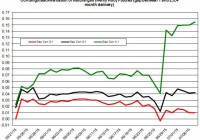Forget Greece, Buy These U.K. ETFs Instead
Uncertainty regarding Greek debt negotiations has continued to dampen investor sentiment since the start of this year. To add to the crisis, Greece overwhelmingly voted against the austerity package offered by lenders last Sunday. This poses serious questions about the economic future of the nation and whether it will continue to use the euro. On the other hand, economic doldrums in the continent seem to have had little impact on the U.K. The country has outperformed the major economies, including the U.S., China and Japan, attracting investors’ attention in recent times. Greek Crisis In the recent past, several opinion polls have shown that a vote on the Greek issue of continuing to be a member of the common currency bloc would be a close affair. However, on Sunday, 61% of citizens voted against adopting further austerity measures, escalating the crisis further. Meanwhile, Greece needs to pay 3.5 billion euros to the European Central Bank (ECB) on July 20. Greece faces the threat of exiting the currency bloc if it fails to make debt payments to the ECB within the stipulated time frame. The failure to do so could also lead the ECB to trim its emergency lending to Greek banks, eventually hampering the country’s financial system. Additionally, Eurozone leaders gave Greece a Sunday deadline to submit new aid proposals. Greece needs to come up with new economic measures to avoid a default. On Tuesday, Greek Prime Minister Alexis Tsipras proposed short-term financing until the end of July from its lenders. Tsipras asked for an interim financing in exchange for some policy overhauls demanded by Greece’s creditors. Separately, the IMF said last week that the country would need a significantly large amount of funds for debt relief. Moreover, an economic crisis lasting more than seven years and youth jobless rates as high as 50% have put additional pressure on the economy. Why U.K.? While escalating Greek debt concerns continued to weigh on Europe, it’s the U.K. which has bucked the trend. According to official data, GDP rose by 0.4% for the January-March period. This is higher than the previous estimate of 0.3%. Additionally, year-over-year growth for the first quarter was also revised upward to 2.9% from the earlier estimate of 2.5%. GDP growth for 2014 was revised up to 3% from 2.8%. Also, the National Institute for Economic and Social Research estimated that the economy has expanded at a 0.7% clip in the second quarter. It is also projected that the economy will grow at a healthy rate of 2.5% this year. Reportedly, industrial output in the U.K. increased at a better-than-expected monthly pace of 0.4% in May. Also, the slump in oil prices and low inflation boosted consumer confidence in the region. A separate report showed that market research company GfK’s consumer confidence index increased by six points to a total score of seven in June, its highest point in 15 years. A year-on-year increase of 4.5% in first-quarter real disposable income was the sharpest pace of growth since 2001. Moreover, wage growth increased to 2.7% in April, witnessing the fastest pace of growth in four years. While private jobs rose 3.3% in April and the public sector posted a 0.3% gain, joblessness has declined in the U.K. for nearly six years. 2 U.K. ETFs to Buy The encouraging economic data indicates that the economy in the U.K. is on a solid footing and is emerging as the only hope in Europe. It is speculated that the country will continue on its robust growth path this year as well as the next. In this scenario, investors may consider the following two favorably ranked U.K. ETFs to strengthen their portfolio and offset Greek debt concerns. First Trust United Kingdom AlphaDex ETF (NYSEARCA: FKU ) This fund provides exposure to 74 firms by tracking the Defined United Kingdom Index. The fund has amassed $362.3 million in its asset base, while it has an average daily volume of around 97,000 shares. None of the firms account for more than 2.9% of the total assets. Sector-wise, financials take the top spot at about 30.7% share, while consumer discretionary and industrials also have double-digit allocation. FKU charges a fee of 80 bps annually and has a Zacks Rank #2 (Buy) with a Medium risk outlook. The fund has returned 10.9% over the past six-month period. SPDR MSCI United Kingdom Quality Mix ETF (NYSEARCA: QGBR ) With AUM of $2.7 million, this product tracks the MSCI UK Quality Mix A-Series Index. In total, it holds 112 securities with nearly 31.5% of its assets allocated to the top 10 holdings. From a sector look, financials take the top spot at 16.1%, while information technology, consumer staples, consumer discretionary, energy and industrials round off the top five. The ETF is the cheapest choice in its domain as it charges only 30 bps in annual fees. QGBR trades in light volume of around 4,000 shares a day. It has returned 3.7% in the last six months and has a Zacks Rank #2 (Buy). Original Post
